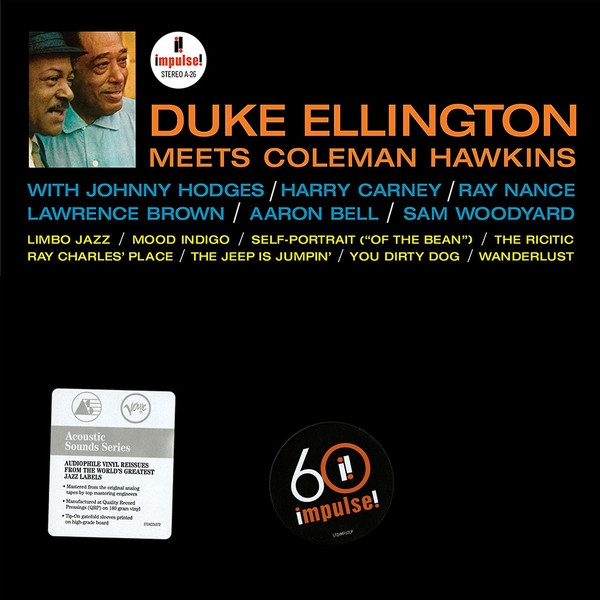| Columns Retired Columns & Blogs |
now I know what was going on in music on the day I was born. I should check it out.

Ellington and Hawkins had never recorded together, so there was an atmosphere of energy and something grand and long overdue. Producer Bob Thiele and engineer Rudy Van Gelder stayed out of the way and let the music unfold while making sure not to miss anything. The result was a spectacular, loose, joyous, perfectly played album: Duke Ellington Meets Coleman Hawkins (Impulse! Records, AS-26, A-26 in mono).
The opening number, "Limbo Jazz," which Stanley Dance, in his detailed liner notes, says was "conceived quite spontaneously halfway through the session," sets the tone. With Woodyard calling out key changes, the band takes off on a Latin riff as Hawkins changes his reed. About two-thirds of the way through, with no audible warm-up, Hawkins steps up to a mike on the left side of the soundstage and blows a great solo. The album is off to the races.
Next up, a beautiful rendition of the Ellington classic "Mood Indigo." After Ellington's men, particularly Hodges, set the tune in motion, Hawkins appears on the right, seeming to step out of the speaker, a living and breathing man in my listening room. Other highlights include "Wanderlust," the side-A closer, with its round-robin solos; "Self Portrait (of the Bean)," written by Ellington for Hawkins, referencing the latter's nickname; and the album finale, "The Ricitic." Notice, at around 4 minutes, how Hawkins's sound goes from left toward the middle as Van Gelder opens the fader on Nance's violin. Also notice the interplay between Ellington, Bell, and Woodyard at the end.
The holographic illusion of Hawkins stepping forward of the right speaker on "Mood Indigo" was my first experience with higher-end hi-fi, on a friend's system in the late 1990s. That generous friend later gave me his copy of the original LP. I have expected this cipher-saxman to step out of the right speaker every time I've played the album since. Alas, none of the CD issues satisfied.
Most of the subsequent reissues—there have been quite a few—have been on Impulse!. Germany's Speakers Corner Records reissued the LP in 2007, cut from a high-quality copy tape at Emil Berliner Studios, which then was in Hanover. Analogue Productions released a 45rpm version three years later, with lacquers cut by Kevin Gray. I haven't heard that version. The Speakers Corner version sounds quite different from the original, partly due to a different tape source and partly to the very different mastering chains. Rudy recorded the session direct to an Ampex 300 tubed two-track recorder and cut the original LP on his Scully lathe fitted with a somewhat unique cutting system from Fairchild (footnote 1). In Germany, Berliner's AAA cutting system was a Studer tape machine feeding a Neumann cutting system based on a VMS-70 lathe, all solid state.
The most recent version of Duke Meets Hawk, released in 2022 but widely available only recently, is the Verve–Analogue Productions reissue cut by Ryan Smith at Sterling Sound Nashville from what sounds like the same copy tape used by Speakers Corner. (The master tape reportedly burned up in the Universal Hollywood vault.) Playback was from an Ampex ATR-100 with a custom preview-delay loop to interface with Sterling's Neumann VMS-80 lathe and solid state cutting system. This newest version sounds most similar to the Speakers Corner LP, but it too has unique sonic qualities.
Which one sounds best? Each LP version has something to recommend it, and each may sound better or best on your system, depending on your tastes.
The original LP sounds of its time: somewhat thin and veiled by today's standards but with strength in its crisp midrange, which is part of what propels the life force of Hawkins out of the right speaker when his "Mood Indigo" solo begins, and which brings out his slight grunting and breathing as he bears down on it. Whether you prefer that original sound or a more modern sound is a matter of taste, as demonstrated by the back-and-forth between me and my colleague Alex Halberstadt, which he wrote about in his Brilliant Corners column. The Speakers Corner version has a quiet, modern surface and an extended top and bottom end and retains the life-force elements, although they aren't as pronounced because there's more detailed sound around them. In short, it sounds more like a modern LP. RVG's recording stands tall in the bigger spotlight.
The new Verve-AP version takes the modern elements of the Speakers Corner platter even further. The surfaces are quieter, and the average level is a bit higher. It sounds very different from the original LP. The bottom end smokes the old disc, and the treble is more present and detailed. Those who love the old records may well argue that all that fidelity and extension diffuses the life force of the original. I understand this point of view, which is why I keep that original and the Speakers Corner LP. On my system, Hawkins still steps out of the right speaker, and there's more detail around him. But because of that very detail—that higher fidelity—he doesn't step as far into the room.

now I know what was going on in music on the day I was born. I should check it out.

I have the AP 45rpm version. Sounds fantastic. One of my favorite recordings.